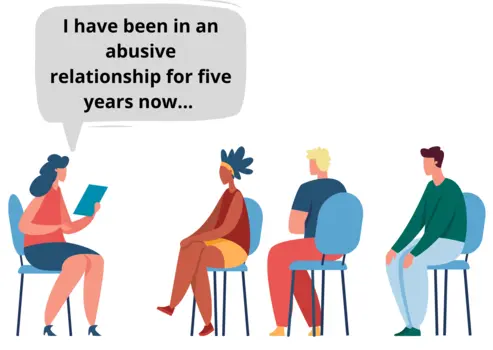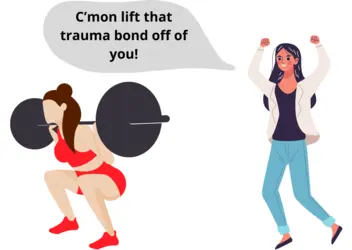Being in a trauma bonded relationship is deeply invalidating, devaluing, dehumanizing, chaotic, and traumatizing. It forces victims of abuse to neglect their own thoughts, feelings, emotions, and needs. It corrupts the core values and sense of self of the victim, and it causes a tremendous amount of self-doubt, guilt, shame, anxiety, and depression. If being in a trauma bonded relationship is that bad, what does breaking a trauma bond feel like?
Breaking a trauma bond feels destabilizing, painful, and chaotic. The victim of abuse is going to experience intense withdrawal symptoms, an intense level of confusion about the abuse, they’re going to feel stuck in life, they’re going to have different trauma responses, and they’re going to feel emotionally unstable.
This article is going to guide you though the different thoughts, feelings, emotions, and needs that come with breaking a trauma bond but we’ve also create a short video below that outlines some reliable signs that a trauma bond is over that you should be aware of while on your healing journey.
A Short Video About the Signs That a Trauma Bond Is Over
Why Does Breaking a Trauma Bond Make You Feel so Bad?
If you want to make sure that you survive the second wave of trauma that breaking a trauma bond brings, you have to understand why breaking a trauma bond makes you feel so bad. Attempting to manage abuse without a comprehensive grasp of what you’re up against is the fastest way you can land yourself back into the abuse cycle you worked so hard to escape.
Your Abuser’s Projection Becomes Your Identity
One thing that abusers are really good at is manipulating their victims into becoming incapable of conceptualizing a sense of self. You can read more about this in our article Is Trauma Bonding Intentional but through intrusive behaviors like gaslighting, mirroring, and intermittent reinforcement, abusers are able to hold a significant amount of power and control over others by hijacking their victim’s identity.
Once this happens the abuser is able to turn the victim into a repository for all of their suppressed negative emotions. The abuser will then project all of their negative emotions like shame, a crippling sense of being inadequate, fear of abandonment, and emotional instability onto their victim.
It’s not true for all abusers but as a general rule abusers project their negative emotions onto their victim because they are so emotionally inadequate that they are incapable of regulating the negative emotions on their own. By projecting all of their negative emotions onto others they are able to maintain a falsified identity that supports their fragile, vulnerable, and insecure sense of self.
Moving on, what this level of manipulation and intrusion does is it strips the victim of their core values, sense of direction in life, and independence and “rebuilds” their sense of self with all of the abuser’s negative emotions. This leaves the victim under the false impression that they are as worthless as the abuser is making them feel.
What this means is that when the victims break the trauma bond, they have to begin to rebuild themselves again which can feel destabilizing, painful, and chaotic because of how long they’ve been invalidated, devalued, and dehumanized by their abuser.

You Have a Ton of Ruminating Thoughts
When someone’s psyche becomes consumed with excessive and intrusive thoughts about negative experiences and feelings, it is called rumination and it is very common for victims of abuse to experience it.
Rumination is quite interesting because it can manifest in the form of someone continuously thinking about what they could have done better to make the trauma bonded relationship work and it can manifest in the form of someone constantly thinking about how to get justice, closure, or revenge on their abuser.
The fact of the matter is that victims of abuse are not going to get anything but pain and confusion from their abuser. What this means is that rumination is actually an abuser’s powerful secret weapon because it keeps the victim trapped within the abuse cycle even after they’ve physically escaped it.
Rumination can cause breaking a trauma bond to feel confusing, immobilizing, and trigger intense symptoms of withdrawal like fatigue, exhausting, and restlessness. This is because after months, years, and even decades of abuse, it is very common for victims to feel uncomfortable letting go of their abuser and putting their thoughts, feelings, emotions, and needs first.
Breaking a trauma bond is an incredibly demanding task for someone in such a vulnerable state because as we mentioned before, breaking a trauma bond requires victims of abuse to dismantle the identity that the abuser built for them and rebuild it on their own. Of course, they can have guidance from a qualified professional and/or a solid support group, but victims of abuse are going to have to do all of the heavy lifting of breaking a trauma bond on their own!

The Post Separation Abuse Disrupts Your Healing Journey
Sadly, abuse doesn’t end when the abusive relationship ends. Abusers often feel entitled to having power and control over their victim for as long as they see fit. When an abuser continues to abuse his/her victim after the relationship has ended, it is called post separation abuse and it can manifest in a variety of different ways.
Some of the most common ways post separation abuse manifests is through counter parenting, isolation, stalking and harassment, alienation allegations, legal abuse, coercive control, financial abuse, and neglectful or abusive parenting.
There are a ton of different forms of post-separation abuse but the point is that it makes breaking the trauma bond extremely hard.
It’s very common for victims of abuse to feel unstable emotionally and experience a variety of different trauma responses when they’re in the presence of their abuser or reminded of their abuser in some way, shape, or form. A trauma response is an emotional response to trauma and there are four types of them: flight, fight, freeze, and fawn.
The Four Types of Trauma Responses
A flight trauma response is when someone literally or figuratively runs away from the trauma in their life. For example, someone who dives into alcohol to avoid all of the trauma that they have from years of domestic violence is figuratively running away from their trauma.
If this same person were to not dive into alcohol but instead up and leave their home to move to the other side of the country without a solid or logical approach to rebuilding themselves, they would be literally running away from the trauma.
A fight response originates from one’s belief that having power and control over others is the best way to accumulate love, acceptance, and safety. The fight response is a very narcissistic response so the example below is just for information, it isn’t meant to suggest a victim of abuse would respond in this manner.
Imagine that someone was giving a presentation to their colleagues but was criticized about the professionalism of his work. Instead of taking the criticism and learning from it, he flies into a narcissistic rage and throws a chair through a window, that is called a fight response.

The freeze response is a manifestation of someone being caught between the fight response and the flight response. When someone responds to trauma by freezing they are very aware of their surroundings and try to gather enough data to make a decision about what they should do next.
For example, if a victim of abuse were to freeze up while checking out of a grocery store, meaning she wouldn’t respond to the cashier or pay for the groceries, because she saw her ex-abuser, it would be called a freeze response.
The fawn response is when people escape trauma with a variety of people pleasing behaviors. For example, imagine that a victim of abuse was reading a book and minding their own business when all of a sudden her abuser smashes through the door in a narcissistic rage for no apparent reason at all.
Stricken with fear, the victim begins to apologize for anything and everything that they can think of, offers to make him and his friends dinner, and begins to degrade themselves in front of the abuser to make him calm down, that is a fawn response. The fawn response is all about someone neglecting their own emotions, thoughts, feelings, and needs to escape the trauma.
When it comes to trauma responses, seeking out the guidance of a qualified professional is going to be your best course of action because they are going to be able to help you create a very good plan for developing healthy trauma responses.
What Should You Take Away From This Article?
Healing from abuse is not an easy process. It’s going to require that you wake up every single day and willingly walk into the unknown. It might take years, maybe even decades, before you’re able to truly heal from the trauma you were exposed to but that is a lot better than spending an eternity with someone who devalues, invalidates, and dehumanizes you on a daily basis.
About the Author

Hey, I’m Elijah.
I experienced narcissistic abuse for three years.
I create these articles to help you understand and validate your experiences.
Thank you for reading, and remember, healing is possible even when it feels impossible.
References
Reid, Joan, et al. “Trauma bonding and interpersonal violence.” Psychology of trauma (2013).
